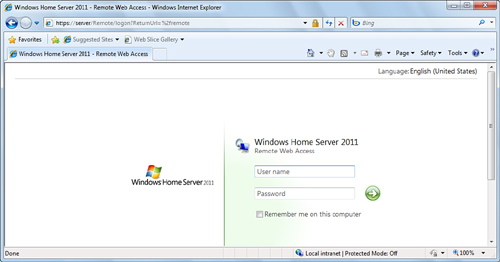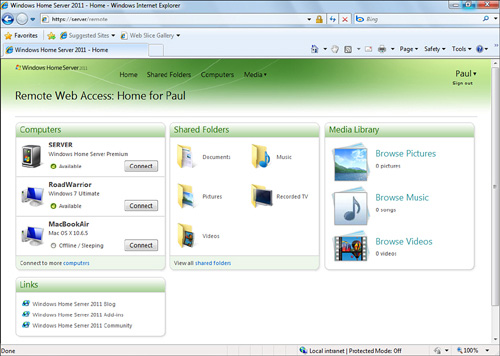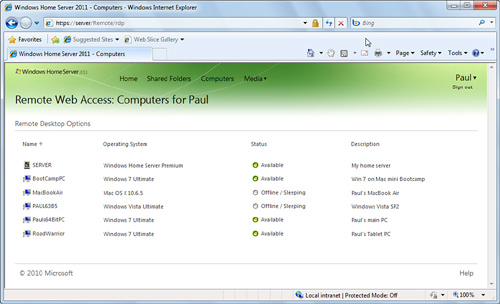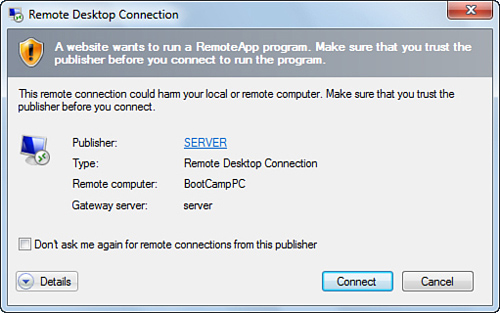You can use the Remote Desktop Connection program to connect to any
Remote Desktop host, even hosts that don’t have the Windows Home Server
Connector software installed. A second method you can use to connect to
Remote Desktop hosts is to go through the Windows Home Server network.
With this method, which is a bit easier than running Remote Desktop Connection directly, you can only connect to hosts that have Windows Home Server Connector installed.
This method runs Remote Desktop Connection behind the
scenes via Windows Home Server. That is, instead of connecting directly
to the remote host, Remote Desktop Connection takes you to the Windows
Home Server, which then shows you the remote computer’s desktop. Up
front, Windows Home Server gives you a simple interface that lists the
available computers to which you can connect. This interface is part of
Windows Home Server Remote Web Access. This is the same interface that
you use to connect to your network via the Internet, as described a bit
later . However, you also use it to connect to a Remote Desktop host over your LAN, which is what I discuss in this section.
For this to work, you must enable the Remote Desktop service on the host, as described earlier , and then be sure to reboot the host PC.
Caution
Windows Home Server’s Remote Web Access feature is not
compatible with Network Level Authentication. Therefore, when you’re
setting up a Windows 7 or Windows Vista host, don’t select the Allow
Connections Only from Computers Running Remote Desktop with Network
Level Authentication option. Instead, select the Allow Connections from
Computers Running Any Version of Remote Desktop option.
Note
It’s crucial that you reboot the host PC after you
enable Remote Desktop; otherwise, Windows Home Server won’t recognize
the PC as being configured for Remote Desktop duties.
Configuring Users for Remote Access
You need to configure Windows Home Server to allow
remote access for the user account that you’ll be using to log on to the
Remote Desktop host. Here are the steps to follow:
1. | Log in to the Windows Home Server Dashboard.
|
2. | Select the Users tab.
|
3. | Double-click the user you want to configure. The user’s property sheet appears.
|
4. | In the Remote Web Access tab, click to activate the Allow Remote Web Access check box.
|
5. | Click
to activate the check box beside each item you want the user to see as a
link on the Remote Web Access page. In particular, activate the
Computers check box to give the user remote access to the network
computers.
|
6. | Click OK.
|
Activating Remote Web Access on the Server
Your final bit of prep involves turning on the Remote Access service in Windows Home Server. Here’s how it’s done:
1. | Log in to the Windows Home Server Dashboard.
|
2. | Click Server Settings.
|
3. | Click the Remote Web Access tab.
|
4. | Click Turn On. Windows Home Server runs the Turn on Remote Web Access Wizard.
|
5. | You don’t need your router configured at this point ,
so click to activate the Skip Router Setup check box, and then click
Next. Windows Home Server configures Remote Web Access on your network
and then prompts you to set up a domain name.
|
6. | Click Close.
|
7. | Click OK.
|
Displaying the Remote Web Access Page
Before you can connect to a remote computer, you need
to log on to Windows Home Server’s Remote Web Access page. This is a
page on the Windows Home Server website that gives you access to the
Remote Desktop hosts on your network, as well as to the Windows Home
Server shared folders. Here are the steps to follow to display the
Remote Web Access page:
1. | On the client, launch the Internet Explorer web browser.
Tip
You can use most modern web browsers—including
Firefox, Safari, and Chrome—to display the Remote Web Access pages, but
you can only remotely access computers using Internet Explorer. To fix
this in Firefox, install the IE Tab add-on (available from ietab.mozdev.org). When you get to the Remote Web Access logon page, right-click the page and then click View Page in IE Tab.
|
2. | Type the following address into the address bar (where server is the name of your Windows Home Server):
|
3. | Press Enter. Windows Home Server redirects you to the Remote Web Access logon page (see Figure 1) at the following address:
https://server/Remote/logon

|
4. | Type
the username and password of your Windows Home Server account, and then
press Enter or click the Go arrow. Windows Home Server displays the
Remote Web Access Home page (see Figure 2) at the following address:

|
Making the Connection
With that done, you can connect to a host computer on your network by following these steps:
1. | Display the Remote Web Access Home page.
|
2. | The
Computers section shows three machines on your network: the server and
two clients. If you want to connect to one of these machines, click its
Connect button; if you don’t see the client you want to connect to,
click the Computers link at the bottom of the list to display the
Computers page, which displays a list of the computers on your Windows
Home Server network, as shown in Figure 3. Note that the Status column shows one of the following four values:
Available—The computer is capable of acting as a Remote Desktop host, and it has the Remote Desktop service enabled. Connection Is Disabled—The computer is capable of acting as a Remote Desktop host, but it doesn’t have the Remote Desktop service enabled. Offline / Sleeping—The computer either is not connected to the network or is in sleep mode. Not Supported on This Operating System—The
computer is not capable of acting as a Remote Desktop host. That is,
the computer is running Windows7 Starter, Windows7 Home Premium, Vista
Home Basic, Vista Home Premium, or XP Home.

|
3. | If
the computer you want to connect to shows Available in the Status
column, click the computer. (If Internet Explorer prompts you to install
an ActiveX control, be sure to install it.) The Remote Desktop
Connection dialog box appears, as shown in Figure 4.

|
4. | Click Connect. Windows Home Server prompts you to log on to the client.
|
5. | Log on to the remote computer.
Note
If you connect to the Windows Home Server machine, you end up at the Dashboard, not the Windows Home Server desktop.
|
Disconnecting from the Host
When you finish with the Remote Desktop session, you have two choices for disconnecting:
Using the host desktop, select Start, Log Off.
Display the Connection bar and click the Close button.
When you return to the Windows Home Server Remote Access page, click Sign Out to end your session.